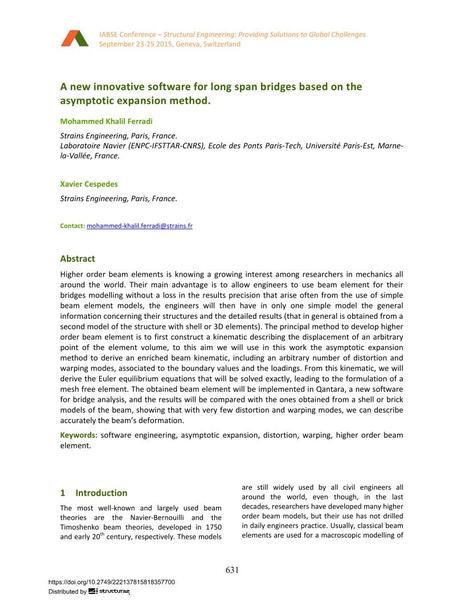A new innovative software for long span bridges based on the asymptotic expansion method.

|
|
|||||||||||
Détails bibliographiques
| Auteur(s): |
Mohammed Khalil Ferradi
(Strains Engineering, Paris, France; Laboratoire Navier (ENPC-IFSTTAR-CNRS), Ecole des Ponts Paris-Tech, Université Paris-Est, Marne- la-Vallée, France.)
Xavier Cespedes (Strains Engineering, Paris, France.) |
||||
|---|---|---|---|---|---|
| Médium: | papier de conférence | ||||
| Langue(s): | anglais | ||||
| Conférence: | IABSE Conference: Structural Engineering: Providing Solutions to Global Challenges, Geneva, Switzerland, September 2015 | ||||
| Publié dans: | IABSE Conference Geneva 2015 | ||||
|
|||||
| Page(s): | 631-635 | ||||
| Nombre total de pages (du PDF): | 5 | ||||
| Année: | 2015 | ||||
| DOI: | 10.2749/222137815818357700 | ||||
| Abstrait: |
Higher order beam elements is knowing a growing interest among researchers in mechanics all around the world. Their main advantage is to allow engineers to use beam element for their bridges modelling without a loss in the results precision that arise often from the use of simple beam element models, the engineers will then have in only one simple model the general information concerning their structures and the detailed results (that in general is obtained from a second model of the structure with shell or 3D elements). The principal method to develop higher order beam element is to first construct a kinematic describing the displacement of an arbitrary point of the element volume, to this aim we will use in this work the asymptotic expansion method to derive an enriched beam kinematic, including an arbitrary number of distortion and warping modes, associated to the boundary values and the loadings. From this kinematic, we will derive the Euler equilibrium equations that will be solved exactly, leading to the formulation of a mesh free element. The obtained beam element will be implemented in Qantara, a new software for bridge analysis, and the results will be compared with the ones obtained from a shell or brick models of the beam, showing that with very few distortion and warping modes, we can describe accurately the beam’s deformation. |
||||
